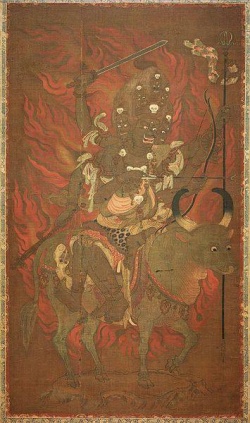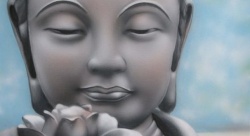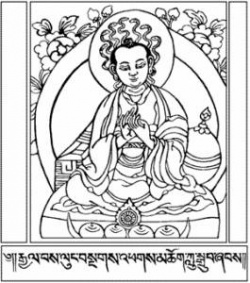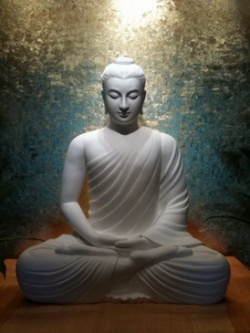Yamantaka
Yamantaka (Skt. Yamāntaka; Tib. གཤིན་རྗེ་གཤེད་, Wyl. gshin rje gshed) — literally 'The Destroyer of Yama, the Lord of Death', is a wrathful form of Manjushri.
Forms
Sarma
In the Sarma tradition, the Yamantaka Tantras are classified as the second category of Father Tantra, known as the Anger class. There are sometimes said to be three forms of Yamantaka: Red Yamari, Black Yamari and Vajrabhairava.
In the Kagyé
Yamantaka also appears as one of the eight deities of Kagyé (see image) , where he is also known as Manjushri Body ('jam dpal sku). The instructions related to this form of Yamantaka are based on the so-called "four chakras": secret or abiding chakra, chakra of existence, cutting chakra, and chakra of manifestation.[1]
In the Longchen Nyingtik, the Yamantaka practice related to Palchen Düpa is called "Overpowering Yama, Lord of Death" ('jam dpal gshin rje 'chi bdag zil gnon).
Other
Yamantaka is also one of the four male gate keepers.
Notes
- ↑ See Kongtrul (2005), pp. 321-322
Further Reading
- Jamgön Kongtrul Lodrö Tayé, The Treasury of Knowledge: Systems of Buddhist Tantra, Ithaca: Snow Lion, 2005
Empowerments Given to the Rigpa Sangha
- Trulshik Rinpoche, Lerab Ling, June 25th, 2003. 'jam dpal tshe bdag yang zlog me'i spu gri'i sgrub thabs rnon po nad gcod kyi dbang dbang bka' from Döjo Bumzang.
"Razor of Fire", dark blue Yamantaka with three faces and six arms. This was practised by Nubchen Sangye Yeshe, who received it from Guru Rinpoche. Up to that point it was kama, but then it was hidden as a terma.
Yamāntaka (Sanskrit: यमान्तक Yamāntaka; Tibetan: Shinjeshe, གཤིན་རྗེ་གཤེད་, རྡོ་རྗེ་འཇིགས་བྱེད།, Wylie: gshin rje gshed; rdo rje 'jigs byed; Japanese: 大威徳明王, Daïitokumyouou (abbr. Daïitoku); Chinese: 大威德金剛; pinyin: Dà wēidé jīngāng; Mongolian: Эрлэгийн Жаргагчи Erlig-jin Jarghagchi) is a Mahāyāna Buddhist iṣṭadevatā (tib. yidam) of the Highest Yoga Tantra class in Vajrayana, popular within the Geluk school of Tibetan Buddhism.
Yamāntaka is seen as a wrathful manifestation of Mañjuśrī, the bodhisattva of wisdom, and in other contexts functions as a dharmapala, or 'Dharma-protector'.
Within Buddhism, "terminating death" is a quality of all buddhas as they have stopped the cycle of rebirth, samsara.
Yamantaka, then, represents the goal of the Mahayana practitioner's journey to enlightenment, or the journey itself: in awakening, one adopts the practice of Yamāntaka – the practice of terminating death.
"Yamantaka" or "Shri Bhagavan Yamantaka" (श्री भगवान् यमान्तक; Glorious Lord Making an End of Yama*) is another name for Shri Vajramahabhairava , who is the highest emanation of Bodhisattva Manjushri.
Bodhisattva Manjushri, Shri Vajrabhairava and Shri Bhagavan Yamantaka together represent the Buddhadharmakaya (Body of Enlightened Doctrine) which is also called Vajradhara (Holder of the Thunderbolt) because it holds to the pledge of the thunderbolt (vajrasamaya) which is the pledge to carry out the action of the Buddha.
How does Yamāntaka terminate death?
This question depends upon the meaning ascribed to the term death – but one way in which this ability can be identified is through the enlightening activity of wisdom.
The wise mind is able to perceive that death has no intrinsic, concrete existence: our understanding of death emerges solely from the conventions of the world. Also, when we achieve the same realization of Yamantaka - who is a Buddha - then we have transcended death.
There are three types of death spoken of in the Yamāntaka Tantra :
Outer death is the regular end of life, which is embodied by Yama, Lord of Death, who resides in the south, seven stories under the earth.
The inner death is ignorance of the true nature of non-dual reality. Instinctive habitual grasping and aversion to objectively "real" objects and subjects arises from this ignorance.
The secret death is dualistic appearance on the subtlest level of clear light mind and illusory body. With the practice of Yamāntaka one overcomes those types of death and gains immortality as a Buddha.
Yamantaka in Japanese Buddhism
In Japanese esoteric teachings, he is known as Daiitoku Myoo (大威德明王) and is the wrathful emanation of Amida Nyorai and is pictured with six faces, legs and arms holding various weapons while sitting on a white cow, symbolizing pure enlightenment.
Etymology
Yamāntaka is a Sanskrit name that can be broken down into two primary elements: Yama, the name of the god of death; and antaka, or "terminator".
Thus, Yamāntaka's name literally means "the terminator of death".
Vajramahabhairava is also a Sanskrit name that can be broken down into two elements: Vajra, Maha Bhairava.
Bhairava means "Terrible" or "Frightful", is a name of the god, and maha means "great".





